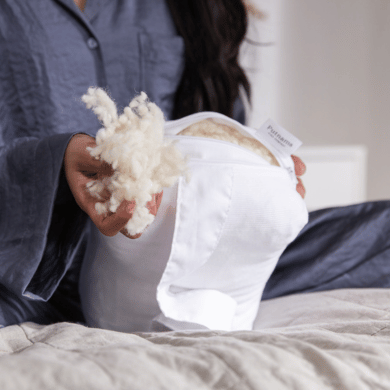
Ultimativer Leitfaden zum Waschen von Kissen: Pflegetipps für verschiedene Materialien
Haben Sie sich jemals Gedanken darüber gemacht, wie viel Zeit Sie mit dem Kopf auf einem Kissen verbringen? Untersuchungen des Bettenherstellers Dreams legen nahe, dass wir etwa ein Drittel unseres Lebens schlafend im Bett verbringen – das entspricht über 225.000 Stunden, eingekuschelt in unsere Kissen . Kein Wunder also, dass Kissen, selbst mit schützenden Bezügen, zu den Haushaltsgegenständen gehören, die regelmäßig gewaschen werden müssen.
Dieser umfassende Ratgeber führt Sie durch alles, was Sie über die Pflege von Kissen wissen müssen, von Waschmethoden je nach Material bis hin zur Beseitigung hartnäckiger gelber Flecken.
Egal ob Sie Hausbesitzer sind, Eltern, denen ein gesundes Umfeld für ihre Familie am Herzen liegt, oder einfach nur einen hygienischen Wohnraum frei von Staub und Allergenen schaffen möchten – dieser Ratgeber ist genau das Richtige für Sie.
Waschmethoden je nach Kissenmaterial
Unterschiedliche Kissenmaterialien erfordern unterschiedliche Reinigungsmethoden. Zu wissen, aus welchem Material Ihr Kissen besteht, ist der erste Schritt zur richtigen Pflege.
Federkissen
Federkissen sind sehr traditionell und benötigen etwas mehr Pflege als ihre synthetischen Pendants. Experten empfehlen, Federkissen in der Waschmaschine zu waschen, dabei ist es wichtig, kaltes Wasser und ein Feinwaschmittel zu verwenden. Um Verklumpungen zu vermeiden, waschen Sie am besten zwei Kissen gleichzeitig, um die Wäschemenge auszugleichen, oder geben Sie ein paar Handtücher hinzu.
Ein schonender Waschgang ist am besten geeignet, um die Struktur der Federn zu erhalten.
Graphit-Latex-Kissen
Graphit-Latex-Kissen sollten ebenfalls mit Vorsicht behandelt werden. Wenn Sie unsere kurze Anleitung befolgen, können Sie die Lebensdauer Ihres Kissens verlängern.
- Pflegehinweis für den Bezug : Nur Handwäsche! Genau wie bei allen Baumwoll-/Wollprodukten.
- Pflegehinweise für die Schaumstoffinnenseite : Flecken mit einem milden Reinigungsmittel und warmem Wasser entfernen.
- Für optimale Frische : Saugen Sie den Schaumstoff gelegentlich ab.
- Lufttrocknen : Nach der Reinigung bei Raumtemperatur trocknen lassen.
- Hinweis zur Sonneneinstrahlung : Schaumstoff vor direkter Sonneneinstrahlung und Hitze schützen.
- Nur der Bezug : Der Bezug darf nicht in der Waschmaschine gewaschen werden – nur Handwäsche!
- Hinweis zu Schaumstoff : Schaumstoff sollte niemals in der Waschmaschine oder von Hand gewaschen werden; Hitzetrocknung oder chemische Reinigung sollten vermieden werden.
Synthetische Kissen
Synthetische Kissen bestehen in der Regel aus Polyester oder anderen Kunstfasern und sind daher leichter zu reinigen. Die meisten synthetischen Kissen können im Schonwaschgang mit warmem Wasser gewaschen werden. Verwenden Sie eine kleine Menge Feinwaschmittel, um Rückstände zu vermeiden.
Memory-Schaum-Kissen
Kissen aus Memory-Schaum dürfen niemals in der Waschmaschine gewaschen werden.
Reinigen Sie die betroffenen Stellen stattdessen mit einem feuchten Tuch und einem milden Reinigungsmittel.
Experten empfehlen, Staub und Schmutz mit einem Staubsauger mit Polsteraufsatz zu entfernen. Lufttrocknung ist für Memory-Schaumstoff unerlässlich, um Schimmelbildung zu vermeiden.
Wollkissen
Wollkissen dürfen nicht in der Waschmaschine gewaschen werden. Es empfiehlt sich jedoch, sie so oft wie möglich auszulüften (am besten an der Sonne), um die Frische und Formbeständigkeit der Wolle zu erhalten. Die Bezüge sind teilweise abnehmbar und waschbar, und Flecken auf der Wolle selbst können punktuell entfernt werden.
Bio-Buchweizenkissen
Wir wissen, dass Sie alle schon darauf gewartet haben. Um die Lebensdauer Ihres Bio-Buchweizenkissens zu maximieren, ist die richtige Pflege wichtig.
Geben Sie ein Bio-Buchweizenkissen NICHT in die Waschmaschine. Die Buchweizenschalen können durch die Flüssigkeitssättigung stark beschädigt werden und müssen ersetzt werden. Die folgende Anleitung soll eine sichere und hygienische Pflege Ihrer Bio-Buchweizenkissen gewährleisten.
So waschen Sie Ihr Bio-Buchweizenkissen:
-
Buchweizenschalen entfernen : Öffnen Sie zunächst den Reißverschluss des Kissens und schütten Sie die Buchweizenschalen in einen großen Behälter. Achten Sie darauf, dass der Behälter sauber und trocken ist.
-
Kissenbezug waschen : Der Bezug kann in der Regel in der Waschmaschine gewaschen werden. Verwenden Sie kaltes Wasser und ein mildes Waschmittel im Schonwaschgang. Vermeiden Sie Bleichmittel oder Weichspüler.
-
Bezug trocknen : Lassen Sie den Bezug an der Luft trocknen oder verwenden Sie einen Trockner bei niedriger Temperatur. Stellen Sie sicher, dass er vollständig trocken ist, bevor Sie ihn wieder befüllen.
-
Reinigung der Buchweizenschalen : Die Schalen selbst müssen nicht gewaschen werden, aber man kann sie zum Auslüften und Auffrischen in der Sonne ausbreiten.
-
Das Kissen wieder zusammensetzen : Sobald der Bezug trocken ist, füllen Sie ihn wieder mit den Buchweizenschalen.
Regelmäßige Pflege wie diese sorgt dafür, dass Ihr Kissen frisch bleibt und seine Lebensdauer verlängert wird.
Wie man gelbe Flecken aus Kissen entfernt
Gelbe Flecken auf Kissen sind ein häufiges Problem und entstehen meist durch Schweiß, Hautfett oder Speichel. So werden Sie sie entfernen:
Vorbehandlung
Vor dem Waschen sollten Flecken mit einem Fleckenentferner vorbehandelt werden. Tragen Sie den Entferner direkt auf den Fleck auf und lassen Sie ihn etwa 15 Minuten einwirken. Alternativ kann eine Paste aus Backpulver und Wasser helfen.
Waschgang
Nach der Behandlung waschen Sie Ihre Kissen gemäß den Pflegehinweisen des jeweiligen Materials. Bei maschinenwaschbaren Kissen kann eine Wäsche bei hoher Temperatur (54 °C) mit einer Tasse Weißweinessig oder einer halben Tasse Backpulver helfen, Flecken zu entfernen.
Sonnentrocknung
Das Trocknen an der Sonne ist eine hervorragende Methode zur weiteren Aufhellung. Die Sonne wirkt als natürliches Bleichmittel, reduziert die Sichtbarkeit verbleibender Flecken und desodoriert gleichzeitig Ihre Kissen auf natürliche Weise.
Wie oft sollte man Kissen waschen?
Die kurze Antwort lautet: definitiv häufiger, als Sie denken!
Regelmäßiges Waschen ist entscheidend für die Gesundheit Ihrer Kissen. Lucy Ackroyd , Designchefin bei Christy, rät: „Ihre Kissen sollten alle drei bis vier Monate gereinigt werden.“ Diese Häufigkeit reduziert die Ansammlung von Allergenen und sorgt dafür, dass Ihre Kissen frisch und stützend bleiben.
Allergien berücksichtigen
Für Allergiker oder Menschen mit Atemwegserkrankungen empfiehlt es sich, Kissen häufiger zu waschen. Ein Waschen alle zwei Monate ist ratsam, um die Allergenbelastung so gering wie möglich zu halten.
Kissenschoner
Kissenbezüge können die Waschintervalle verlängern, da sie als Barriere gegen Öle und Schweiß wirken. Waschen Sie die Bezüge alle zwei bis drei Wochen zusammen mit Ihrer Bettwäsche.
Bewährte Methoden zum Trocknen von Kissen
Das richtige Trocknen von Kissen ist genauso wichtig wie das Waschen. Unzureichendes Trocknen kann zu Schimmelbildung führen.
Trocknertipps
Für maschinentrocknergeeignete Kissen verwenden Sie eine niedrige Temperaturstufe. Trocknerbälle oder saubere Tennisbälle helfen, die Kissen aufzulockern und ein Verklumpen der Füllung zu verhindern.
Lufttrocknung
Für Kissen aus Memory-Schaum oder Latex ist Lufttrocknung unerlässlich.
Legen Sie sie flach an einem gut belüfteten Ort oder im Freien in die Sonne. Vermeiden Sie es, sie aufzuhängen, da sich die Füllung dadurch verschieben kann.
Auf Feuchtigkeit prüfen
Stellen Sie sicher, dass die Kissen vor Gebrauch vollständig trocken sind. Jegliche Restfeuchtigkeit kann zu Schimmelbildung führen, was sowohl unansehnlich als auch unhygienisch ist.
Waschmaschine vs. Handwäsche
Ob man das Kissen in der Waschmaschine wäscht oder von Hand wäscht, hängt maßgeblich vom Material ab.
Waschmaschine
Maschinenwäsche ist für die meisten Daunen-, Baumwoll- und Synthetikkissen praktisch und effektiv. Beachten Sie stets die Pflegehinweise auf dem Etikett und verwenden Sie einen Schonwaschgang mit einem milden Waschmittel.
Händewaschen
Handwäsche ist für empfindliche Materialien wie Memory-Schaum, Latex und Wolle am besten geeignet. Verwenden Sie lauwarmes Wasser und eine kleine Menge Waschmittel. Drücken Sie das Kissen vorsichtig aus, ohne es zu verdrehen oder auszuwringen, um die Füllung nicht zu beschädigen.
Letzte Drehung
Bei Kissen, die zwar maschinenwaschbar sind, aber besondere Pflege benötigen, empfiehlt es sich, auf den Schleudergang zu verzichten und stattdessen das überschüssige Wasser vorsichtig von Hand auszudrücken und die Kissen an der Luft trocknen zu lassen. Denn nichts ist so wohltuend wie der Duft frisch gewaschener Wäsche, um den Stress des Tages hinter sich zu lassen.
Schlaf gut und lass dich nicht von Bettwanzen beißen!
Regelmäßige Kissenpflege ist unerlässlich für ein sauberes und komfortables Schlafklima. Vom Verständnis der Bedürfnisse verschiedener Materialien über die Entfernung hartnäckiger Flecken bis hin zur ordnungsgemäßen Trocknung – jeder Schritt ist entscheidend für einen gesunden Schlaf.
Sich Zeit für die Pflege seiner Kissen zu nehmen, kann die Schlafqualität verbessern und ein gesünderes Zuhause schaffen.


















Hinterlassen Sie einen Kommentar